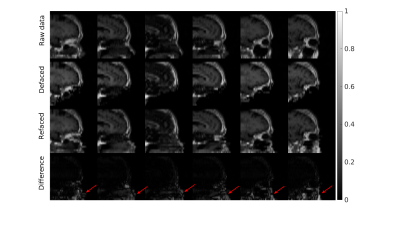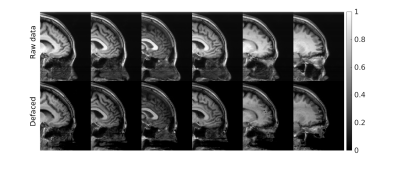Zuojun Wang1, Peng Xia1, Wenming Cao2, Kui Kai, Gary Lau1, Henry Ka Fung Mak3, and Peng Cao1
1Diagnostic Radiology, Department of Diagnostic Radiology, HKU, Hong Kong, China, 2Department of Diagnostic Radiology, HKU, HongKong, China, 3Department of Diagnostic Radiology, HKU, Hong Kong, China
1Diagnostic Radiology, Department of Diagnostic Radiology, HKU, Hong Kong, China, 2Department of Diagnostic Radiology, HKU, HongKong, China, 3Department of Diagnostic Radiology, HKU, Hong Kong, China
In this study, we utilized a cycle generative adversarial network to anonymize brain MRI data. The model showed reliable performance when testing on T1-weighted images, and we also extend our network application to the unseen MPRAGE images, targeting different brain MRI contrasts.

Figure 3: One case from testing on T1w images. The model performs well regarding face removal without destroying irrelevant tissues, such as the skull base and bottom of the frontal brain lobe. The raw and deface-refaced images were unidentical, showing the deface was irreversible. Difference maps were from the subtraction of the raw and deface-refaced images. (red arrows).

